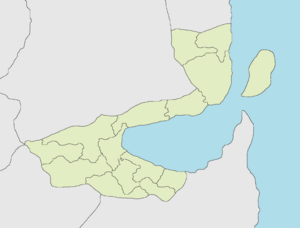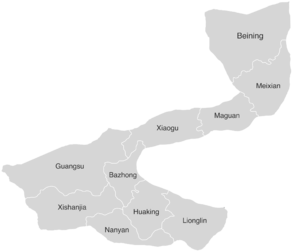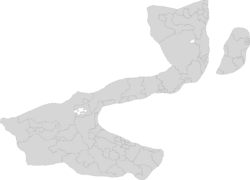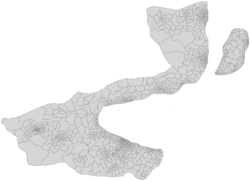Administrative divisions of Monsilva
| Monsilvan states | |
|---|---|
| |
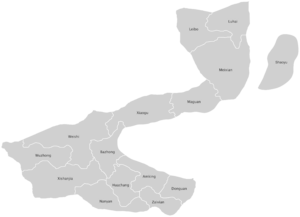 | |
| Category | Federated state |
| Location | |
| Number | 15 |
| Populations | 1,326,622 (Zaixian) – 11,535,841 (Amking) |
| Government |
|
| Subdivisions |
|
The Monsilvan Republic, being a federal state, consists of 15 individual political entities known as states (Monsilvan: 州, Pinyin: Zhōu). Each state holds governmental juristiction over a specific geographic territory of Monsilva where it shares sovereignty with the federal government. Federalism was an important aspect that was discussed by the provisional government when the Monsilvan Republic was being founded after the mass protests in 1978. According to the federal government, some topics, such as foreign affairs and defence, are the exclusive responsibility of the federation (i.e., the federal level), while others fall under the shared authority of the states and the federation. The states retain residual or exclusive legislative authority for all other areas, including "culture", which in Monsilva includes not only topics such as the financial promotion of arts and sciences, but also most forms of education and job training (see Education in Monsilva). Though international relations including international treaties are primarily the responsibility of the federal level, the constituent states have certain limited powers in this area: in matters that affect them directly, and in areas where they have the legislative authority they have limited powers to conclude international treaties "with the consent of the federal government".
Shaoyu, as a free state is the only outlier state in the federation. Unlike Monsilva's other 14 states, Shaoyu has far more power over matters that involve them, such as the ability of the executive government of Shaoyu is permitted to represent the state internationally without permission from the federal government. Shaoyu is also the only state permitted to lawfully pass legislation that goes against federal law, for example, in a hypothetical scenario where the Monsilvan government declares mandatory conscription, the Shaoyunese government is permitted to pass legislation prohibiting residents of the state from being conscripted.
Every Monsilvan state has its own state parliament whose members are elected by citizens who reside within the state during Monsilvan state elections. The last Monsilvan state elections were in May 2023. States possess many powers and rights granted by the federal government. States and their citizens are represented in the Parliament of Monsilva, a bicameral legislature consisting of the Senate and the Legislative Assembly. States are divided into legislative constituencies which are represented by a single member of the assembly (MLA) in the Legislative Assembly.
Historically, the tasks of local law enforcement, education, healthcare, and local transportation and infrastructure, have generally been considered primarily state responsibilities, although all of these now have significant federal funding and regulation as well. The constitution of Monsilva allows for frequent alterations which have changed the powers of states occasionally since it was written in 1983. The constitution does allow the admission of new states, and this power was last used in 2024 for the state of Shaoyu. Before this, the power had not been used since 1984 to admit Wuzhong during the national re-organization.
Contents
History
Federalism is a new concept within Monsilvan history. The Kingdom of Great Shan consisted of 'territories' but these were not federated as they held no individual power. After the Monsilvan Civil War in the Kingdom of Monsilva, federalism was a frequently discussed topic, but the government never approved any laws relating to devolution, let alone federalism.
The boundaries were rewritten in 1978, after the 1978 mass protests and the collapse of the Kingdom of Monsilva. However, the new states were not made into actual entities until the writing of the constitution of Monsilva in 1983. Monsilva has had 15 states since 2024, with the addition of Shaoyu.
States
Monsilva had been a unitary state since its first establishment in 1830 as the Kingdom of Monsilva until 1978. During the establishement of the Monsilvan Republic, the creation of states was a topic that had been discussed frequently, but without a real answer on where to put them and what powers they should be granted. The administrative divisions of Monsilva remained undetermined until the writing of the constitution of Monsilva in 1983, when the first 10 states were determined. During the national re-organization, this number was increased to 14 with the division of Guangsu into Weishi and Wuzhong; Beining into Leibo, Luhai and a northern part of Meixian; Huaking into Huachang and part of Amking; and Lionglin into the other part of Amking, Donguan and Zaixian. In 2024, Shaoyu was added as Monsilva's fifteenth state.
The use of the term 州 (Zhōu) ("states") dates back to 1953, when prime minister Liang Huiqing introduced states as divisions which were groups of already existing counties, which had been established in 1830 after the Monsilvan Civil War. The term was only used as a distinction of different areas of the country, as the states had no individual power until the Monsilvan Republic. Similar to states, under the Kingdom of Great Shan, the country was split into 领土 (Lǐngtǔ) ("territories"), which were administrated directly by the Emperor and their government.
Counties
Although Monsilva still has counties today, that had a different meaning before 1978. After 1830 and before 1953, counties were the largest subdivisions of Monsilva and had their own local governments. These local governments had very limited power, and the national government could override any decisions made by the local governments. Counties were often used in sports as teams and players would become champions of thier county and then proceed to national competitions. In 1953, when the Zhōu were introduced, counties lost a lot of their importance, as their local governments were disbanded and sports became state-based rather than county-based.
Modern counties, since 1978, are the main subdivision of states. In 2024, the total number of counties was increased due to the admission of Shaoyu, however counties on the mainland remained the same.
Districts
There were 140 electoral districts which were used for elections to the Legislative Assembly from 1980 until 2000. They were replaced by legislative constituencies after the passing of the Legislative Reform Act 2001. They elected representatives to the Legislative Assembly using the first-past-the-post electoral system.
List of current States
| State | Since | Capital | Legislature | Premier Deputy Premier |
Pop. (2022) |
GRP (¥; 2022) |
GRP per capita (¥; 2022) |
|---|---|---|---|---|---|---|---|
| — | — | — | — | 58,012,300 | 14920 billion | 257,195 | |
| 1984 | Amking | State Parliament | Liao Yijun-huang Han Chen-min (FDP) |
11,535,841 | 2510 billion | 217,859 | |
| 1978 | Waiping | State Parliament | Yu Mei Dong Lim (FDP) |
2,307,169 | 456 billion | 197,474 | |
| 1984 | Shangrao | State Parliament | Deng Hai Tsui Yun (FDP) |
3,355,008 | 626 billion | 186,581 | |
| 1984 | Chishang | State Parliament | Wang He Yu Zhi (Green) |
1,947,635 | 373 billion | 191,664 | |
| 1984 | Haimao | State Parliament | Tang Xiang Wong Tai (RNP) |
1,353,539 | 248 billion | 183,288 | |
| 1984 | Luhai City | State Parliament | Liang Ming Xu Yating (Luhai First) |
6,094,770 | 1260 billion | 206,181 | |
| 1978 | Maojie | State Parliament | Zhang Guanyu Gao Cheng (FDP) |
4,143,290 | 807 billion | 194,744 | |
| 1978 (re-organized 1984) | Menchi | State Parliament | Tsang Ju Xiao Huang (FDP) |
5,594,884 | 1030 billion | 183,994 | |
| 1978 | Yilan | State Parliament | Liu Xinyi Yu Ah (RNP) |
1,559,261 | 263 billion | 168,511 | |
| 2024 | San Kong | State Parliament | Feinuo Ziming Xiong Xue (Shaoyu Liberation Party) |
8,000,000 | 1530 billion | 190,982 | |
| 1984 | Sanzhong | State Parliament | Hsu Bai Yeung Shui (RNP) |
1,909,182 | 373 billion | 195,524 | |
| 1984 | Wodai | State Parliament | Tsui Chin Chow Yin-jun (FDP) |
3,691,470 | 686 billion | 185,910 | |
| 1978 | Zhangye | State Parliament | Kwan Juan-bo Zhou Yong (FDP) |
3,653,017 | 747 billion | 204,374 | |
| 1978 | Taimali | State Parliament | Man Yan-xiulan Tan Heng (RNP) |
1,540,612 | 281 billion | 182,490 | |
| 1984 | Baoan | State Parliament | Bai Jin Hou Jie (Zaixian Party) |
1,326,622 | 256 billion | 192,954 |
Politics
Monsilva is a federal parliamentary republic. The Monsilvan poltical system is determined by the constitution of Monsilva, any changes to which must gain the support of both the Legislative Assembly and the Senate in order to be passed. The constitution is edited very frequently and is therefore officially considered incomplete, however it is still vital in representing Monsilva's politics.
Government
The federal constitution stipulates that the structure of each Federated State's government must "conform to the principles of democracy, transparency and law". All states consist of a unicameral State Parliament, with a Premier as the head of the government, the head of state for every state is the President of Monsilva. Each state is split into counties, and then again into municipalities. Members of a state parliament are elected via state elections, where citizens use the single-transferable vote system to elect multiple members to their respective legislative constituency. Whichever party has the most seats, or has formed a coalition with another party to form the most, will then place its party leader for that state as the Premier.
Subdivisions
Counties
All states are made up of counties (县; Xiàn). Counties have their own councils, which eligible citizens can vote for representatives in every two years.
Counties can be designated as urban or rural. Rural counties are counties that do not have any settlements with city status. Urban counties can have one of three designations: constituent, city or standard. Constituent counties are part of multiple-county cities and have councils that are usually subordinate to greater city-wide councils. City counties are counties which are administered by a city council instead of a county council, and usually contain a major city that makes up the majority of the county's area. Standard counties are functionally the same as rural counties, with their only difference being that standard urban counties have a settlement with city status. Standard counties can contain autonomous cities, whose subdistricts are administered independently of the rest of the county.
Counties are divided into municipalities and subdistricts. Municipalities are used for local elections, while subdistricts are used as census regions, county elections and for other general administrative purposes.
Monsilva currently has a total of 295 counties.
Legislative constituencies
Legislative constituencies (立法选区; Lìfǎ Xuǎnqū) are separate from counties and municipalities. Constituencies are used for representation in the Legislative Assembly. Each constituency has between 3 and 14 representatives who are elected every four years during federal elections. They were introduced in 2001 after the Legislative Reform Act. They were reformed by the Electoral Reform Act in 2023, which changed them from single-member constituencies elected by IRV to larger multi-member constituencies elected by party-list PR.
Monsilva currently has a total of 84 legislative constituencies.
Municipalities
The municipalities (乡; Xiāng) of Monsilva are divisions of counties used for local government administrations.
Monsilva currently has a total of 1260 municipalities.
Subdistricts and boroughs
Subdistricts (分区; Fēnqū) are political divisions of counties that are used in the Monsilvan census and for other administrative purposes. City and town boundaries are determined by subdistricts, they are then split into boroughs (镇区; Zhènqū) which are used for county elections. Cities will have many boroughs, while most rural subdistricts and many town subdistricts can have very few or even only one borough.
See Also
- Monsilvan Railways Administration - Main rail network run by the federal government
- Postal codes in Monsilva
